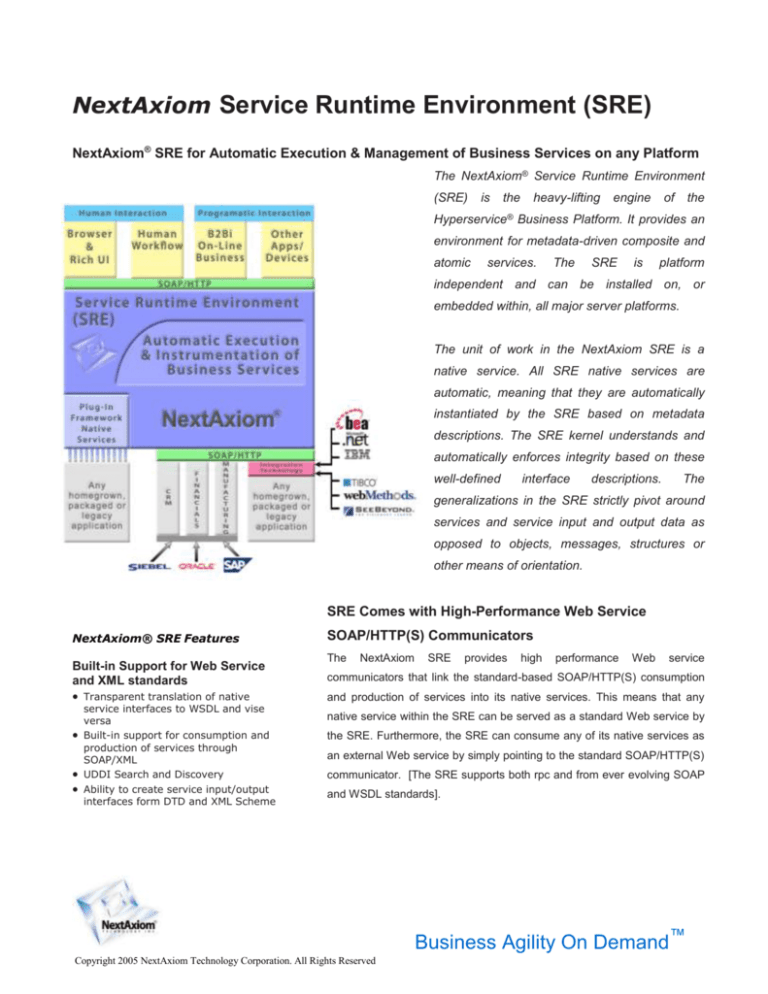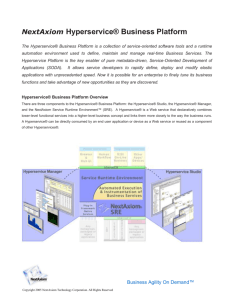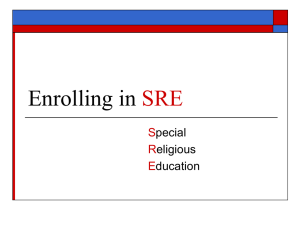
NextAxiom Service Runtime Environment (SRE)
NextAxiom® SRE for Automatic Execution & Management of Business Services on any Platform
The NextAxiom® Service Runtime Environment
(SRE)
is
the
Hyperservice®
heavy-lifting
engine
of
the
Business Platform. It provides an
environment for metadata-driven composite and
atomic
services.
The
SRE
is
platform
independent and can be installed on, or
embedded within, all major server platforms.
The unit of work in the NextAxiom SRE is a
native service. All SRE native services are
automatic, meaning that they are automatically
instantiated by the SRE based on metadata
descriptions. The SRE kernel understands and
automatically enforces integrity based on these
well-defined
interface
descriptions.
The
generalizations in the SRE strictly pivot around
services and service input and output data as
opposed to objects, messages, structures or
other means of orientation.
SRE Comes with High-Performance Web Service
NextAxiom® SRE Features
Built-in Support for Web Service
and XML standards
Transparent translation of native
service interfaces to WSDL and vise
versa
Built-in support for consumption and
production of services through
SOAP/XML
UDDI Search and Discovery
Ability to create service input/output
interfaces form DTD and XML Scheme
SOAP/HTTP(S) Communicators
The
NextAxiom
SRE
provides
high
performance
Web
service
communicators that link the standard-based SOAP/HTTP(S) consumption
and production of services into its native services. This means that any
native service within the SRE can be served as a standard Web service by
the SRE. Furthermore, the SRE can consume any of its native services as
an external Web service by simply pointing to the standard SOAP/HTTP(S)
communicator. [The SRE supports both rpc and from ever evolving SOAP
and WSDL standards].
Business Agility On Demand™
Copyright 2005 NextAxiom Technology Corporation. All Rights Reserved
NextAxiom® SRE Features
Built to Perform
Automatic Service Creation &
Performance
The SRE optimizes the routing of services as an application is executing,
Metadata caching with automatic
update mechanism
Automatic creation and consumption
of services based on metadata
Efficient memory management and
garbage collection for automatic
services
Use of optimized service execution
graphs for the execution of composite
services
Real-time data integrity enforcement
for service input/outputs using molded
look-up structures
Management of Automatic execution
stacks for composite services:
Ability to pre-empt a composite
execution stack
Automatic branch and join of
parallel execution stacks in separate
threads
Embedded execution stacks
corresponding to embedded
composite services
Optimized routing of services
Automated data mapping of service
input/outputs from many-to-many
services
Optimizes algorithms based on
service interfaces
Uses embedded lookup structures
on the “from” and the “to” side
Direct-memory data flow between
outputs and inputs of services
Handles data flow across data
structures of any complexity
Provides optimal mechanisms for
data transformation and
translations
Parallel processing
Multithreaded service execution
Multiprocessor optimized
Throttled parallel processing of
batched requests
Services request-response caching
Auto purge
Auto swap to disk
Configurable cache-keys
Service-level load balancing
consuming automatic services in parallel whenever possible. The SRE
utilizes a sophisticated multithreaded multiprocessor optimized architecture
for simultaneous processing of services requests. When an external or an
automatic request for the consumption of a service is submitted, if the
service is atomic, the SRE dispatches its plug-in implementation in a light
thread of execution.
If the service is a composite service, the SRE ensures that it has cached a
Service Execution Graph corresponding to the metadata definition of that
composite service before spinning its light thread of execution. The Service
Execution Graph corresponds to the order and dependency of innerservices within a composite service and holds information to automatically
manage the scope and life cycle of the automatic services that are to be
consumed inside the composite service. Based on the corresponding
execution graph, the SRE instantiates automatic native services and maps
the actual data across the outputs and inputs of connected inner-services.
To allow rapid data flow and transformation between services, the
NextAxiom SRE has implemented optimal algorithms for mapping data
between the inputs and outputs of services based on their interfaces. This
allows the SRE to eliminate the overhead of XML transformation common
to other approaches and to increase data flow between services to inmemory lookup speeds.
As the SRE automatically instantiates and
consumes inner-services, it recognizes parallel processing opportunities
based on the dependency of services in the execution graph and branches
and manages parallel stacks of execution.
If any inner-service is also a composite service, the SRE creates and
manages multi-level execution stacks corresponding to each inner-service
in separate threads of execution (patent-pending). These multi-level stacks
of execution can be embedded to a virtually unlimited depth of composition
and are automatically created, managed and destroyed by the SRE. The
NextAxiom SRE automates many performance enhancement features
through its multi-level stacks of execution. For example, it can
simultaneously run multiple input datasets for an atomic or composite
service instance, known as a “batch” or “for each” processing, in parallel,
and automatically merge the output data sets.
Business Agility On Demand™
Copyright 2005 NextAxiom Technology Corporation. All Rights Reserved
NextAxiom® SRE Features
SRE Automatically Enforces Data Integrity for Service
Context Management and
Automated Transactional Support
Inputs and Outputs On-the-Fly
Supports context-sensitive behavior
for services inside a composite
service:
Caching
Data Mapping and Transformation
Load balancing
Fail-over and Exception handling
Conditional execution
Logging
Transactional framework for Service
Plug-ins
Automated start of transaction when a
composite service is marked as a
transactional boundary
Composite transactional context
management
Automated Commit, Rollback of
transactional resources within a
boundary based on composite service
metadata
Automated dispatch of compensating
services upon rollback
The NextAxiom SRE provides near-instantaneous integrity enforcement for
service input and output data sets based on standard service interface
descriptions (WSDL). This allows runtime integrity checking of each service
request with nearly zero performance degradation.
As an external SOAP/HTTP(S) request or an automatic internal request for
the consumption of a service is issued, the SRE ensures that the related
composite or atomic XML metadata is cached into patent-pending lookup
and routing structures.
Next, the SRE enforces integrity of the actual
service input data using a molding technique in only a matter of
nanoseconds for typical input data sets (patent-pending). As a result, when
the input data does not correspond to the types and restrictions described
in the metadata schema, the service request is rejected and the integrity
violation is automatically identified and systematically reported to the
consumer. Similarly, after the execution of the service, the SRE enforces
integrity for the actual output data of the service. Other methods of
commercially available integrity validation are so slow that they are often
turned off when the application is placed into production.
SRE Automatically Manages the Context of a Native
Service
In the NextAxiom SRE, a native service is a virtual thread of execution with
its own context. The SRE context mechanism for a composite service
enables its inner services to behave differently for various applications
without violating the fundamental encapsulation of their interfaces. For
Automatic Inter-Service
Communications Mechanisms
Pre-emptive Wait and notify for builtin Request Events upon consumption
of other services
Shared Memory Management with
persistence option for Shared Vault,
Array, Data Dictionary and Shared
Data Containers
Automatic locking and synchronization
of service instances based on
composite service metadata
Non-intrusive dispatch of Service
Triggers upon start of execution,
failure, success or end of execution for
any service
example, this context mechanism enables context-sensitive behavior for
features such as service caching, logging and security. When a composite
service is declared as a transaction boundary, the SRE maintains a
composite transaction context for its inner services that will be
automatically rolled back, compensated, or committed.
SRE Automates Inter-Service Communication
The NextAxiom SRE provides a range of automated inter-service
communication mechanisms that support high-performance synchronous
and asynchronous service consumption. For example, the SRE issues a
built-in consumption event when a service with a specified correlation key
Business Agility On Demand™
Copyright 2005 NextAxiom Technology Corporation. All Rights Reserved
NextAxiom® SRE Features
SRE Standard Service Plug-ins
and Built-in Constructs
File System access
Database access
Messaging Queue interactions
FTP, Email, HTTP(S), POP3, SMTP,
SNMP, OS Command line, Encryption
etc.
Lightweight built-in functions for
common operations such as
mathematical, date, and string
manipulation
Runtime support for configurable
services such as sort and filter for
service inputs/outputs
is consumed. The execution of a native composite service can be placed in
a holding state and pre-empted from the SRE Kernel while waiting for one
or more service consumption events. In this way, the SRE supports the
execution of long running business services. The SRE also provides builtin trigger mechanisms to non-intrusively start the execution of a trigger
based on the consumption of a specified service. In addition, the SRE
provides built-in shared memory mechanisms for sharing data across
native services.
SRE Guarantees Correctness of Execution for MissionCritical Services
An SRE service is a multithread-safe resource and can automatically hold a
synchronization lock to prevent the simultaneous execution of a declared
group of services that are correlated through key input data of the service.
This built-in synchronization guarantees the correct behavior of a business
service. For example, when a Credit Account and a Debit Account service
are declared as a synchronized service group and correlated through their
common account number input data, at runtime the SRE guarantees that
no two instances of Credit Account and/or Debit Account with the same
account number will be consumed at the same exact time.
SRE Natively Bridges to Legacy and Other Environments
through a Service Plug-in Mechanism
In addition to using SOAP/HTTP(S) to consume a service, the SRE can
dispatch the implementation of an atomic service directly into its memory
space through a built-in service plug-in mechanism. In fact, the built-in
SOAP/HTTP(S) communicators are simply service plug-ins. The SRE
supports a layer to alias the URI of a service plug-in and a late binding
mechanism that works based on the programmatic capability of the
Hyperservice Studio to conditionally switch the implementation of any
atomic service at execution time. The Service plug-in framework provides
optional interfaces for a plug-in to participate in the automated transactional
feature of the NextAxiom SRE.
Business Agility On Demand™
Copyright 2005 NextAxiom Technology Corporation. All Rights Reserved
NextAxiom® SRE Features
SRE System Service Plug-ins
Services to configure and initialize
SRE parameters
Persistent data repository services
used by shared memory and other
mechanisms
Service monitoring and management
Service metering and log
management
WSDL services
HTML Service Interface
Documentation
UDDI Search and Service Discovery
Metadata Search and Discovery
Comprehensive metadata
management services including
metadata management services for:
Service Accounts/Projects and
Packages
Service Interfaces
SRE Domains
Service Plug-in registration and
configuration
Request Event
Triggers
Regression Test Cases
Composite service metadata
management
Security and Web service Deployment
Services including
User Authentication
User Authorization Services based
on role-based access control
treating Accounts/Projects,
packages, service interfaces and
composite service definitions as
security resources
Account Provisioning Services for
deploying managed consumable
Web services that are metered
SRE Supports Many Standard Service Plug-ins and HighPerformance Built-in Constructs Out-of-the-Box
The NextAxiom SRE is shipped with the runtime for numerous service
Plug-ins that support native services for access to databases, file systems,
operating system functions, FTP, email, and messaging queues to name a
few. In addition, the SRE supports high-performance and low overhead
built-in functions for
common uses such as mathematical calculations, date, number, and string
manipulation. The SRE also supports the runtime for configurable services
such as those used for sorting and filtering the actual output data of other
services in the Studio.
SRE Comes with a Services Management Foundation
The NextAxiom SRE provides comprehensive built-in instrumentation for
profiling, metering, monitoring, provisioning, and security management of
services. The SRE optionally logs service activity including requests,
responses, status, processing times, hosts, and users. Activity logs can be
tailored to output through flat files, databases or any data source via
services. NextAxiom SRE security features include user authentication and
access control. The SRE authenticates users through either its embedded
username/password management or through a plug-in architecture to any
third party security infrastructure. Users are assigned to roles in order to be
granted access to services. NextAxiom SRE measurement and security
features,
when
teamed
with
Hyperservice®
Manager
provide
comprehensive service management solution.
Business Agility On Demand™
Copyright 2005 NextAxiom Technology Corporation. All Rights Reserved
a
NextAxiom® SRE Features
SRE is an Agile Architectural Marvel for SOA
Tailorability
You may hear us say: “we have built our system on top of itself” or that “our
All platform functionality built on sets
of System Services
Atomic System Services can bind to
customized service plug-ins
Atomic System Services can bind to
Composite Services
Composite System Services can be
seamlessly tailored through Studio
System Services can bind to the SRE
SOAP/HTTP(S) plug-in and thus their
functions delegated to another system
system is the first example of a pure SOA implementation on a very large
scale”.
A closer look at the architecture of the Hyperservice Business
Platform will demonstrate what we mean. The Hyperservice Studio and
management tools communicate with the SRE strictly through sets of welldefined services referred to as System Services. For example, the serviceprofiling tool consumes a service from NextAxiom’s System Log package to
obtain a list of logged service instances. As another example, Studio’s
initial login screen consumes a service to authenticate the user. It then
Virtualization
Internal vs. Remote Invoker
abstraction as an extension of SRE to
invoke System Services
Ability to serialize/de-serialize
embedded stacks of execution for
remote service debugging and to preempt running services from CPU and
restore the exact state at a later time
or on a different machine
Ability to transparently create clusters
of SRE with metadata links across
clusters
consumes a service to get a list of projects that the user is authorized to
see and once the user selects one of those projects, it invokes another
service to get all the service packages and names within that project and
populates them in the project pane. When the user clicks to open a
Hyperservice definition in the project pane, the Studio consumes a service
to retrieve the metadata for that definition. In summary, behind every
function supported by Studio or a NextAxiom management tool is a System
Service that runs through an SRE.
The SRE itself accomplishes most of its tasks through sets of System
Services. For example, when it receives a request for running a composite
service, it calls a service to retrieve the metadata for the composite service.
Or, when the SRE needs to log a service consumption event, it invokes a
service for logging. The service for logging may be an atomic or a
composite service that consumes other services. Atomic System Services
are simply implemented through the SRE service plug-in mechanism and
these services can bind to different implementations at anytime.
Composite System Services are directly implemented within Hyperservice
Studio and can be tailored to meet specific needs with extreme agility.
Remarkably, since most of the platform functionality is built on top of
System Service building blocks, one can use the Hyperservice Studio to
further automate administrative tasks through the composition and
aggregation of its System Services.
The Studio, management tools and SRE use a layer of abstraction for
consuming System Services referred to as service Invoker interface. Two
implementations of the Invoker are used within NextAxiom products: 1) the
first is referred to as the Internal Invoker that communicates with the core,
Kernel module of SRE within the same computer address space, 2) the
Business Agility On Demand™
Copyright 2005 NextAxiom Technology Corporation. All Rights Reserved
second is referred to as the Remote Invoker that assumes the target SRE
is on another networked computer and uses SOAP/HTTP(S) to
communicate with the target SRE. The Kernel of the SRE itself uses the
Invoker abstraction to consume all of the System Services required for
implementing its own functionality such as metadata access and
management,
service
logging,
cache
management
and
process
management. This architecture has profound implications on the
distribution and virtualization of the SRE. For example, this implies that an
SRE on one machine can transparently access the metadata of a remote
SRE on a networked machine by simply using a corresponding Remote
invoker instead of its own internal invoker when consuming metadata
management services. It is the unparallel ease of virtualization and the
agility to customize the functionality of the Hyperservice Business Platform
that makes its architecture remarkable.
Business Agility On Demand™
Copyright 2005 NextAxiom Technology Corporation. All Rights Reserved
Leverage SRE to Build Your Own Architectural Marvel
The SRE has one purpose and that is to enable you to rapidly invent pure Service-Oriented Applications that are
inherently agile. Using the SRE in your architecture and you are well on your way of creating your own
architectural marvel. If you are excited by the reality of a pure service-oriented architecture for your IT and
applications, contact NextAxiom today to schedule a demonstration of what the SRE can do for you.
Business Agility On Demand™
Copyright 2005 NextAxiom Technology Corporation. All Rights Reserved








